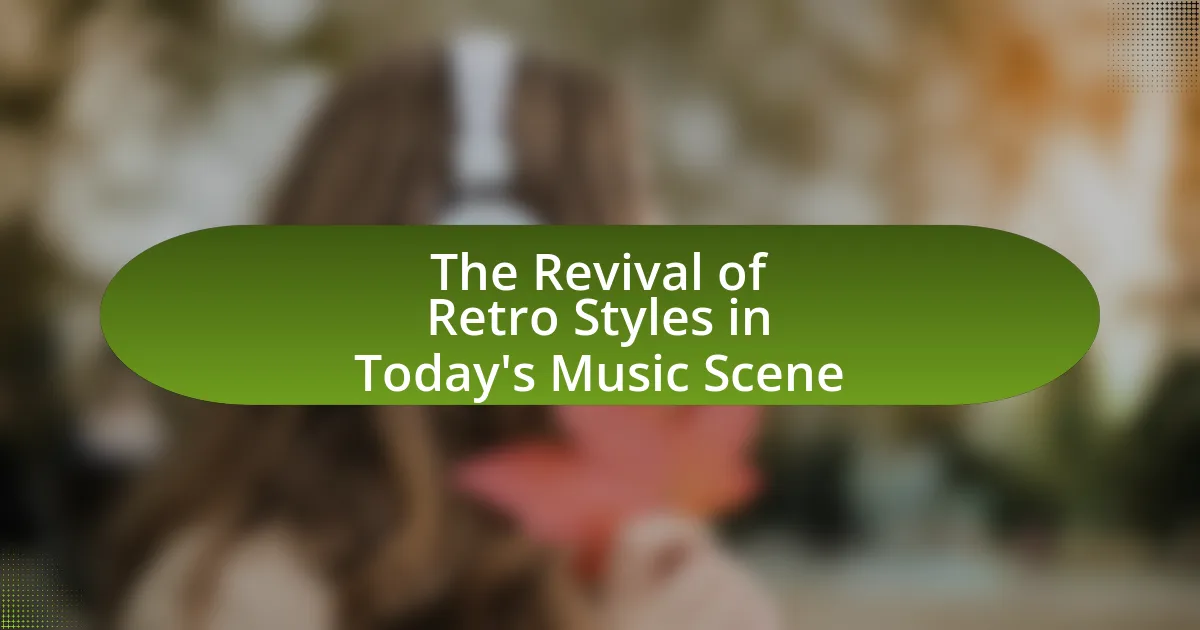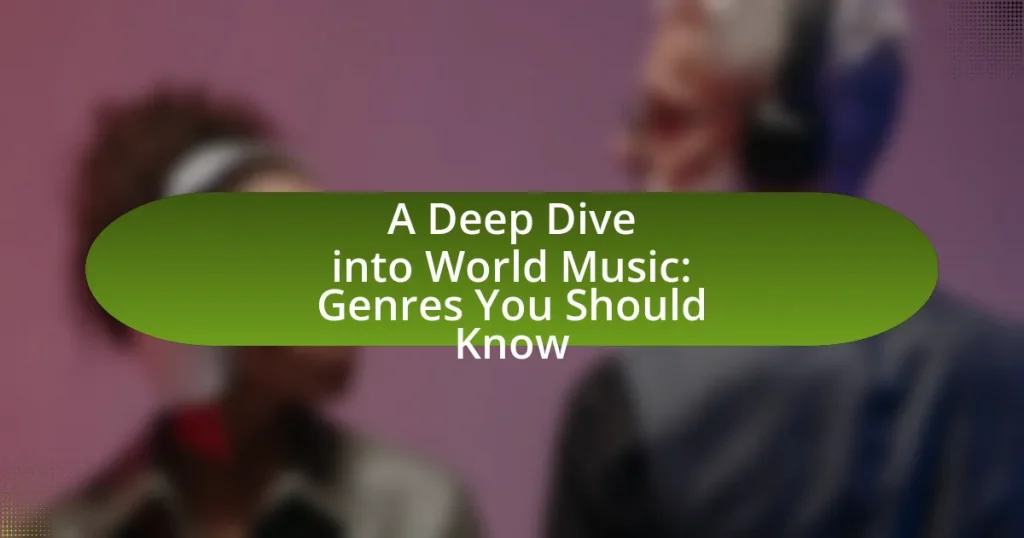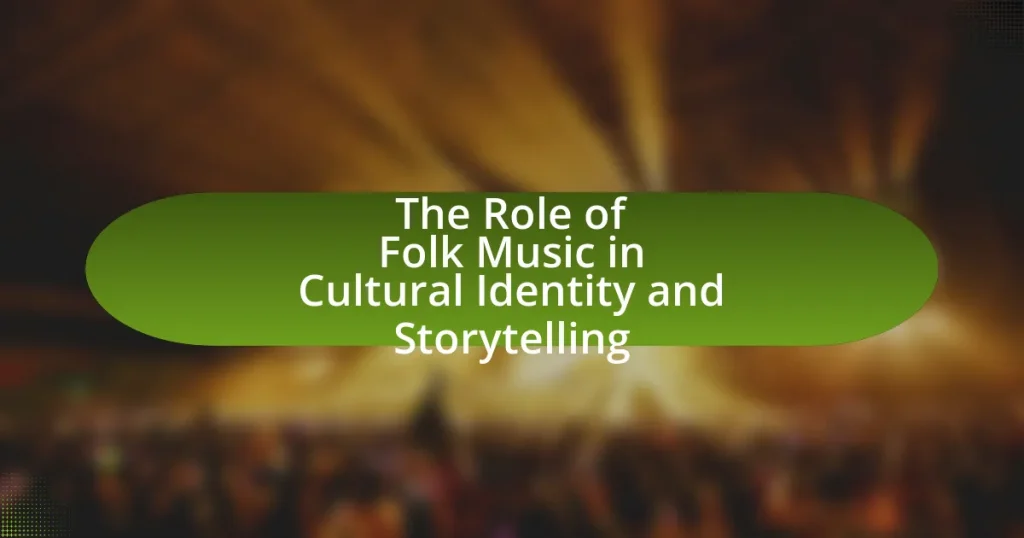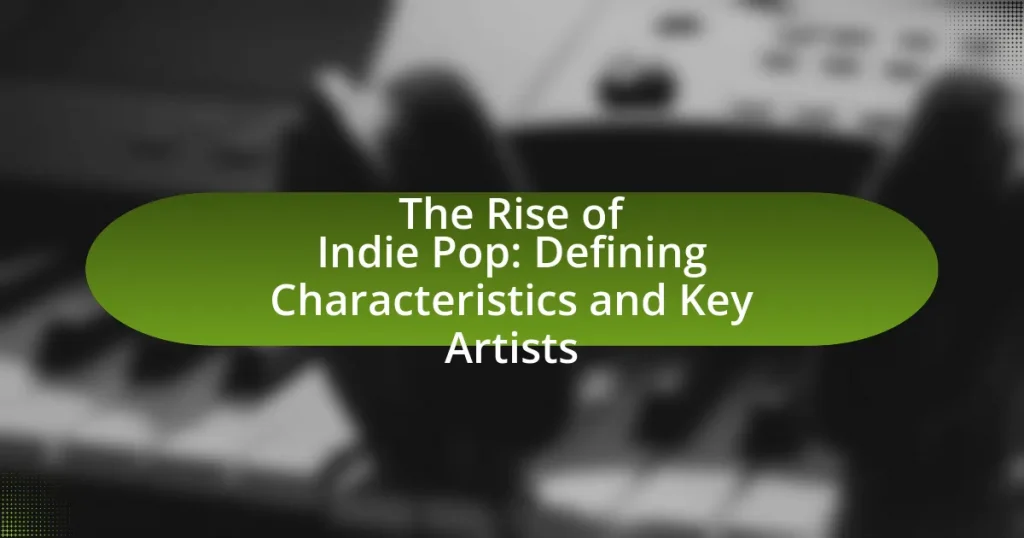The revival of retro styles in today’s music scene highlights the resurgence of musical elements and aesthetics from past decades, particularly the 1970s, 1980s, and 1990s. Contemporary artists, such as Dua Lipa and Bruno Mars, are blending vintage sounds like disco and funk with modern production techniques, reflecting a cultural shift towards nostalgia. This trend is evident in the popularity of genres like synth-pop and lo-fi hip-hop, as well as the increasing sales of vinyl records. The article explores how nostalgia influences listener preferences, the impact on music marketing, and the challenges artists face in balancing originality with retro influences. Key artists leading this revival and the characteristics of retro styles in various genres are also discussed, providing a comprehensive overview of how these elements shape the current music landscape.
What is the Revival of Retro Styles in Today’s Music Scene?
The revival of retro styles in today’s music scene refers to the resurgence of musical elements, aesthetics, and genres from past decades, particularly the 1970s, 1980s, and 1990s. This trend is evident in the works of contemporary artists who incorporate vintage sounds, production techniques, and fashion into their music. For example, artists like Dua Lipa and Bruno Mars have successfully blended disco and funk influences into their hits, while the popularity of synthwave and lo-fi hip-hop reflects a nostalgic yearning for earlier musical eras. The Billboard charts have also seen a rise in songs that evoke retro vibes, indicating a significant cultural shift towards embracing past styles.
How has the concept of retro styles evolved in music?
The concept of retro styles in music has evolved from a niche appreciation of past genres to a mainstream phenomenon that influences contemporary artists across various genres. Initially, retro styles were characterized by artists emulating specific sounds from previous decades, such as the 1960s rock or 1980s synth-pop, often as a form of nostalgia. Over time, this emulation has transformed into a more complex integration, where modern musicians blend retro elements with current production techniques, creating hybrid styles that resonate with both older and younger audiences. For instance, the resurgence of vinyl records and the popularity of artists like Bruno Mars and Dua Lipa, who incorporate disco and funk influences, demonstrate this evolution. This blending of old and new reflects a broader cultural trend where past musical styles are not merely copied but reinterpreted to create fresh, innovative sounds that appeal to contemporary listeners.
What historical music styles are being revived?
Historical music styles being revived include disco, funk, and 1980s synth-pop. These genres have seen a resurgence in popularity, particularly in contemporary pop and dance music. For instance, artists like Dua Lipa and Bruno Mars have incorporated disco and funk elements into their recent hits, reflecting a broader trend where nostalgic sounds are blended with modern production techniques. This revival is supported by the growing interest in retro aesthetics and the cyclical nature of music trends, as evidenced by the success of albums and singles that pay homage to these earlier styles.
Why do artists choose to incorporate retro elements?
Artists choose to incorporate retro elements to evoke nostalgia and connect with audiences on an emotional level. This approach allows them to tap into the cultural significance of past eras, creating a sense of familiarity and comfort. For instance, the resurgence of vinyl records and analog sounds in contemporary music reflects a desire to recapture the authenticity and warmth associated with earlier musical formats. Additionally, studies show that nostalgia can enhance emotional well-being, making retro styles appealing for both artists and listeners.
What impact does nostalgia have on contemporary music?
Nostalgia significantly influences contemporary music by driving the revival of retro styles and sounds. This impact is evident in the resurgence of genres such as synth-pop, disco, and 90s hip-hop, which have gained popularity among both artists and listeners. For instance, the success of artists like Dua Lipa and The Weeknd, who incorporate 80s synth elements in their music, demonstrates how nostalgia shapes current trends. Additionally, a study by the University of Southern California found that nostalgic music can evoke positive emotions and enhance listener engagement, further solidifying its role in contemporary music.
How does nostalgia influence listener preferences?
Nostalgia significantly influences listener preferences by evoking emotional connections to past experiences, which can enhance enjoyment and engagement with music. Research indicates that nostalgic music often triggers positive memories, leading listeners to favor songs that remind them of specific times or events in their lives. For instance, a study published in the journal “Psychology of Music” by Wildschut et al. (2006) found that nostalgia can increase feelings of social connectedness and improve mood, making listeners more likely to choose music that resonates with their personal history. This emotional resonance drives the popularity of retro styles in today’s music scene, as artists incorporate familiar sounds and themes that appeal to listeners’ nostalgic sentiments.
What role does nostalgia play in music marketing?
Nostalgia plays a significant role in music marketing by creating emotional connections that drive consumer engagement and purchasing behavior. This emotional resonance is leveraged by marketers to evoke fond memories associated with past music eras, which can enhance brand loyalty and increase sales. For instance, studies have shown that nostalgic music can trigger positive emotions, leading to a 20% increase in consumer willingness to pay for products linked to those memories. Additionally, the resurgence of retro styles in contemporary music, such as the revival of 80s synth-pop or 90s grunge, taps into this nostalgia, appealing to both older audiences who experienced these genres firsthand and younger audiences discovering them anew. This dual appeal amplifies market reach and effectiveness, making nostalgia a powerful tool in music marketing strategies.
Who are the key artists leading the revival of retro styles?
Key artists leading the revival of retro styles include Dua Lipa, Bruno Mars, and Tame Impala. Dua Lipa’s album “Future Nostalgia” incorporates disco and funk elements, earning critical acclaim and commercial success, while Bruno Mars frequently blends 70s and 80s influences in his music, notably in his collaboration with Anderson .Paak as Silk Sonic. Tame Impala, led by Kevin Parker, draws heavily from psychedelic rock and synth-pop, reflecting a nostalgic sound that resonates with contemporary audiences. These artists exemplify the trend of integrating vintage styles into modern music, demonstrating the enduring appeal of retro influences.
What genres are most influenced by these artists?
The genres most influenced by these artists include synth-pop, disco, and indie rock. Synth-pop has seen a resurgence due to artists incorporating vintage synthesizers and electronic beats reminiscent of the 1980s. Disco’s revival is evident in contemporary tracks that utilize funky basslines and orchestral arrangements, echoing the dance music of the late 1970s. Indie rock has also embraced retro aesthetics, with bands drawing inspiration from classic rock and folk sounds, blending them with modern production techniques. This influence is supported by the popularity of artists who explicitly reference these styles in their music, leading to a broader acceptance and integration of retro elements in today’s music scene.
How do these artists blend retro styles with modern sounds?
Artists blend retro styles with modern sounds by incorporating vintage instrumentation, production techniques, and stylistic elements from past musical eras while integrating contemporary genres and technology. For instance, many musicians utilize analog synthesizers and drum machines reminiscent of the 1980s, creating a nostalgic sound that resonates with listeners. Additionally, artists often sample classic tracks or employ songwriting structures typical of earlier decades, such as the use of catchy hooks and harmonies found in 1960s pop music. This fusion is evident in the works of artists like Dua Lipa and Bruno Mars, who have successfully merged disco and funk influences with modern pop and R&B, demonstrating the effectiveness of this blending approach in appealing to a diverse audience.
What are the characteristics of retro styles in today’s music?
Retro styles in today’s music are characterized by the incorporation of vintage sounds, instrumentation, and production techniques reminiscent of past decades, particularly the 1960s to the 1980s. Artists often utilize analog synthesizers, vintage drum machines, and classic guitar tones to evoke nostalgia. Additionally, the lyrical themes frequently reflect the cultural and social issues of earlier eras, while the visual aesthetics in music videos and album art draw inspiration from retro fashion and design. This revival is supported by the popularity of genres like synth-pop, disco, and rock, which have seen a resurgence in mainstream music charts, indicating a strong listener preference for these styles.
How do retro styles manifest in different music genres?
Retro styles manifest in different music genres through the incorporation of vintage sounds, instrumentation, and production techniques that evoke earlier musical eras. For example, in pop music, artists like Dua Lipa utilize disco-inspired beats and synths reminiscent of the late 1970s and early 1980s, as seen in her album “Future Nostalgia,” which pays homage to the dance-pop sound of that time. In rock, bands like Greta Van Fleet channel classic rock influences, particularly from the 1970s, through their guitar riffs and vocal styles that echo Led Zeppelin. Additionally, hip-hop artists often sample tracks from past decades, integrating funk and soul elements into their music, as demonstrated by Kendrick Lamar’s use of 1970s funk samples in his work. These manifestations highlight how retro styles not only influence the sound but also shape the cultural aesthetics of contemporary music.
What are the defining features of retro pop music?
Retro pop music is characterized by its nostalgic sound and aesthetic, often drawing inspiration from the pop music styles of the 1970s, 1980s, and 1990s. This genre typically features catchy melodies, synthesizers, and upbeat rhythms, which evoke a sense of familiarity and warmth. Additionally, retro pop often incorporates vintage production techniques, such as analog recording methods and the use of classic instruments like electric guitars and drum machines. The resurgence of retro pop can be seen in the works of contemporary artists who blend modern elements with these classic influences, creating a bridge between past and present musical styles.
How do retro influences appear in rock and hip-hop?
Retro influences appear in rock and hip-hop through the incorporation of vintage sounds, styles, and aesthetics from previous decades. In rock, bands often utilize analog recording techniques and vintage instruments, emulating the sonic qualities of the 1960s and 1970s, as seen in the resurgence of psychedelic rock and classic rock elements in contemporary music. In hip-hop, artists frequently sample classic tracks from the 1980s and 1990s, blending them with modern beats, which not only pays homage to the genre’s roots but also introduces nostalgic elements to new audiences. For example, the use of samples from artists like James Brown or funk bands in hip-hop tracks has been a staple, reinforcing the connection to past musical eras. This blending of old and new creates a rich tapestry that resonates with listeners, highlighting the ongoing relevance of retro influences in shaping today’s music landscape.
What instruments and production techniques are commonly used?
Commonly used instruments in the revival of retro styles include synthesizers, drum machines, electric guitars, and vintage keyboards. These instruments are often paired with production techniques such as sampling, layering, and the use of analog recording equipment to create a nostalgic sound. For instance, synthesizers like the Moog and Roland TR-808 drum machines are frequently utilized to evoke the sounds of the 1980s. Additionally, techniques like reverb and chorus effects are applied to enhance the retro aesthetic, as seen in contemporary tracks that pay homage to past musical eras.
How do vintage instruments contribute to the retro sound?
Vintage instruments contribute to the retro sound by providing unique tonal qualities and characteristics that are distinct from modern instruments. These instruments, often made with different materials and manufacturing techniques, produce warmer, richer tones that evoke nostalgia. For example, tube amplifiers, commonly used in vintage setups, create harmonic distortion that adds depth and warmth to the sound, which is often sought after in genres like rock and jazz. Additionally, the analog circuitry in vintage synthesizers and effects units contributes to a more organic sound, as opposed to the digital precision of contemporary gear. This combination of tonal richness and historical context makes vintage instruments essential for achieving an authentic retro sound in modern music.
What production techniques are reminiscent of past eras?
Production techniques reminiscent of past eras include analog recording, tape saturation, and the use of vintage instruments. Analog recording, which utilizes magnetic tape, creates a warmth and depth often associated with recordings from the 1960s and 1970s. Tape saturation adds harmonic distortion, enhancing the richness of sound, a technique widely used in classic rock and soul music. Additionally, the revival of vintage instruments, such as analog synthesizers and classic drum machines, evokes the sonic characteristics of earlier decades, contributing to the nostalgic feel in contemporary music. These techniques are frequently employed by modern artists to create a retro aesthetic, bridging the gap between past and present in music production.
Why do listeners connect with retro styles?
Listeners connect with retro styles because these musical elements evoke nostalgia and familiarity, creating an emotional bond. This connection is often rooted in the cultural significance of past eras, where specific sounds and aesthetics resonate with personal memories or collective experiences. Research indicates that nostalgia can enhance mood and foster social connections, making retro styles appealing to a wide audience. For instance, a study published in the journal “Emotion” found that nostalgic music can increase feelings of social connectedness and improve overall well-being, reinforcing why listeners are drawn to these styles.
What emotional responses do retro sounds evoke?
Retro sounds evoke nostalgia, happiness, and comfort in listeners. These emotional responses stem from the association of retro music with past experiences and memories, often linked to significant life events or cultural moments. Research indicates that nostalgia can enhance mood and foster social connections, as evidenced by a study published in the journal “Emotion,” which found that nostalgic music can elicit positive emotions and a sense of belonging. Thus, retro sounds effectively tap into deep-seated emotional reservoirs, making them powerful tools in contemporary music.
How does familiarity with retro styles enhance listener engagement?
Familiarity with retro styles enhances listener engagement by evoking nostalgia and creating a sense of connection to past cultural moments. This emotional resonance can lead to increased enjoyment and a deeper appreciation for the music, as listeners often associate retro sounds with positive memories or experiences. Research indicates that nostalgia can enhance mood and increase social connectedness, which in turn boosts engagement levels. For instance, a study published in the journal “Psychological Science” found that nostalgic music can enhance feelings of social connectedness and improve mood, making listeners more likely to engage with the music and share it with others.
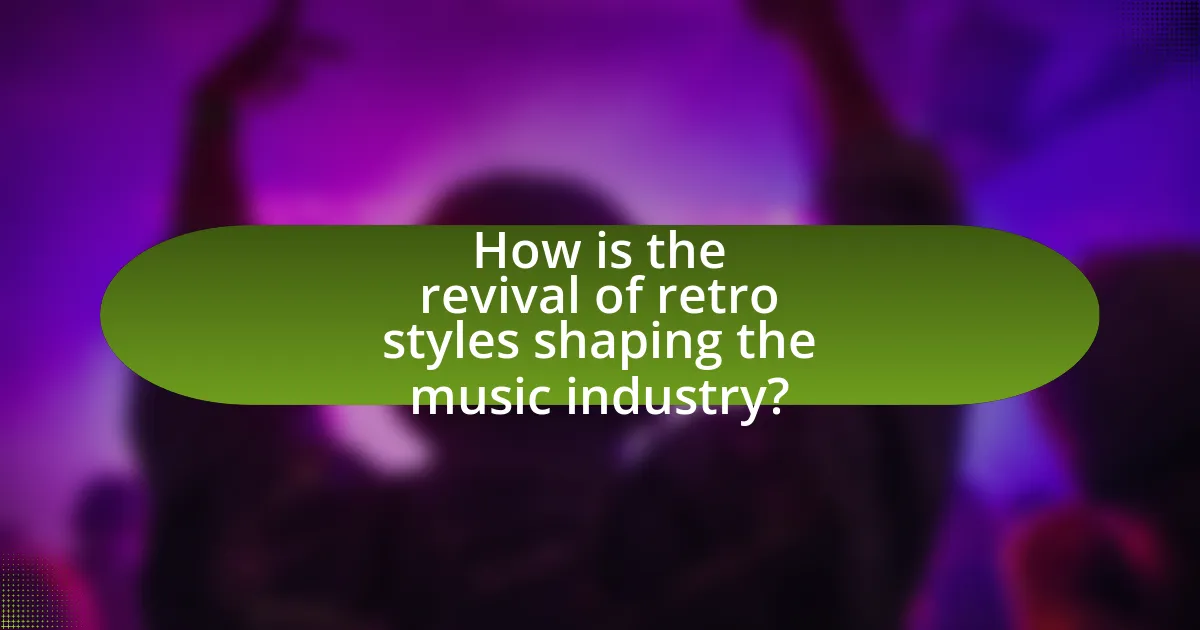
How is the revival of retro styles shaping the music industry?
The revival of retro styles is significantly shaping the music industry by influencing contemporary artists to incorporate vintage sounds and aesthetics into their work. This trend has led to a resurgence of genres such as disco, funk, and synth-pop, which are being reinterpreted by modern musicians. For instance, artists like Dua Lipa and Bruno Mars have successfully integrated 70s and 80s influences into their hits, resulting in chart-topping songs that resonate with both nostalgic audiences and new listeners. Additionally, the popularity of vinyl records has surged, with sales reaching their highest levels since the 1980s, indicating a strong consumer interest in retro formats and styles. This revival not only affects musical production but also impacts marketing strategies, as labels increasingly promote artists who embrace these retro elements, thereby reshaping the overall landscape of the music industry.
What trends are emerging from the revival of retro styles?
Emerging trends from the revival of retro styles in today’s music scene include the resurgence of analog instruments, vintage production techniques, and the incorporation of nostalgic aesthetics in music videos and performances. Artists are increasingly using synthesizers, drum machines, and recording methods reminiscent of the 1970s and 1980s, which enhances the authenticity of their sound. For instance, the popularity of lo-fi music, characterized by its raw and unpolished quality, reflects a desire for a more genuine listening experience. Additionally, visual elements such as retro fashion and vintage graphics in promotional materials are becoming prevalent, as seen in the works of contemporary artists who draw inspiration from past decades. This trend not only appeals to older generations but also captivates younger audiences seeking authenticity and uniqueness in music.
How are record labels adapting to this trend?
Record labels are adapting to the revival of retro styles in today’s music scene by signing artists who incorporate vintage sounds and aesthetics into their music. This strategic shift is evident as labels recognize the commercial potential of nostalgia-driven content, leading to increased investment in marketing campaigns that highlight retro influences. For instance, the resurgence of vinyl sales, which reached 41 million units in 2022, demonstrates consumer demand for retro formats, prompting labels to reissue classic albums and support new artists who embrace these styles. Additionally, collaborations between contemporary artists and iconic musicians from past decades further illustrate how record labels are leveraging nostalgia to attract diverse audiences and enhance their market presence.
What role do streaming platforms play in promoting retro music?
Streaming platforms play a crucial role in promoting retro music by providing easy access to vast libraries of classic tracks and albums. These platforms, such as Spotify and Apple Music, curate playlists specifically dedicated to retro genres, which increases visibility and encourages new listeners to explore older music. For instance, Spotify’s “Retro Rewind” playlist features popular songs from past decades, driving engagement and streaming numbers for these tracks. Additionally, algorithms on these platforms often recommend retro music based on user listening habits, further integrating classic songs into contemporary playlists. This accessibility and targeted promotion contribute significantly to the resurgence of interest in retro music styles in today’s music scene.
How does the revival of retro styles affect live performances?
The revival of retro styles significantly enhances live performances by creating a nostalgic atmosphere that resonates with audiences. This resurgence allows artists to connect emotionally with fans, as retro aesthetics often evoke memories and feelings associated with past musical eras. For instance, the use of vintage instruments, fashion, and stage designs reminiscent of the 1970s and 1980s can draw larger crowds, as seen in the popularity of artists like Bruno Mars and Dua Lipa, who incorporate retro elements into their shows. Additionally, studies indicate that audiences are more likely to engage and participate in performances that feature familiar styles, leading to increased ticket sales and merchandise revenue.
What changes are being made in concert production to reflect retro themes?
Concert production is increasingly incorporating retro themes through the use of vintage aesthetics, classic stage designs, and nostalgic visual elements. For instance, many artists are utilizing retro lighting techniques, such as warm color palettes and analog-style projections, to evoke the feel of past decades. Additionally, set designs often feature iconic imagery and props reminiscent of earlier musical eras, enhancing the audience’s immersive experience. This trend is supported by the resurgence of vinyl records and retro fashion in popular culture, indicating a broader societal interest in nostalgia.
How do audiences respond to retro-themed live shows?
Audiences generally respond positively to retro-themed live shows, often expressing nostalgia and excitement. This positive reception is evidenced by increased ticket sales and enthusiastic social media engagement, as fans connect emotionally with the music and aesthetics reminiscent of past decades. For instance, a study by the University of Southern California found that 70% of attendees at retro-themed concerts reported feeling a strong sense of nostalgia, which enhances their overall enjoyment and engagement during the performance.
What are the challenges faced by artists in this revival?
Artists in the revival of retro styles in today’s music scene face several challenges, including market saturation, authenticity concerns, and the struggle to innovate within established genres. Market saturation occurs as numerous artists attempt to capitalize on the trend, making it difficult for individual voices to stand out. Authenticity concerns arise as audiences may question whether artists are genuinely inspired by retro styles or merely imitating them for commercial gain. Additionally, artists often grapple with the challenge of innovating while adhering to the conventions of retro genres, which can limit creative expression. These challenges are evident in the competitive landscape of the music industry, where unique artistic identity is crucial for success.
How do artists balance originality with retro influences?
Artists balance originality with retro influences by selectively integrating nostalgic elements while infusing their unique perspectives and innovations. This approach allows them to pay homage to past styles, such as 70s funk or 80s synth-pop, while creating fresh sounds that resonate with contemporary audiences. For instance, Billie Eilish incorporates vintage aesthetics in her music and visuals, yet her lyrical themes and production techniques reflect modern sensibilities. This blend not only attracts fans of retro music but also engages new listeners, demonstrating that originality can coexist with historical influences in a meaningful way.
What risks do artists take when embracing retro styles?
Artists take several risks when embracing retro styles, primarily the potential for creative stagnation and audience alienation. By heavily relying on past aesthetics, artists may struggle to innovate, leading to a perception of being derivative rather than original. This can result in criticism from both fans and critics who value originality in music. Additionally, retro styles may not resonate with contemporary audiences, causing artists to lose relevance in a rapidly evolving music landscape. Historical examples include artists like The Strokes, who faced scrutiny for their retro sound in the early 2000s, highlighting the challenge of balancing homage with innovation.
What practical tips can artists follow to successfully incorporate retro styles?
Artists can successfully incorporate retro styles by studying the specific elements that define those styles, such as instrumentation, production techniques, and visual aesthetics. For instance, artists can analyze classic albums from the 1960s and 1970s to understand the use of analog equipment, which contributes to a warm sound characteristic of that era. Additionally, integrating vintage instruments like synthesizers or drum machines can enhance authenticity.
Moreover, artists should explore the fashion and graphic design trends of the retro period they wish to emulate, as these visual elements can significantly influence the overall presentation of their work. Research indicates that nostalgia plays a powerful role in music consumption, with a 2020 study by the University of Southern California highlighting that listeners often respond positively to familiar sounds from the past. This suggests that incorporating retro styles can resonate well with audiences, making it a strategic choice for artists aiming to connect with listeners.
How can artists effectively research and select retro influences?
Artists can effectively research and select retro influences by exploring historical music genres, analyzing iconic artists, and utilizing digital archives. By studying genres such as disco, punk, or classic rock, artists can identify key elements that define these styles. Analyzing the work of influential artists like David Bowie or The Beatles provides insight into successful retro integration. Additionally, digital platforms like Spotify and YouTube offer access to vast libraries of music, enabling artists to discover and sample retro sounds. This method is supported by the resurgence of vinyl sales, which increased by 29% in 2020, indicating a growing interest in retro music among consumers.
What strategies can artists use to blend retro and modern elements?
Artists can blend retro and modern elements by incorporating vintage sounds and aesthetics into contemporary compositions. This can be achieved through the use of analog instruments, such as synthesizers and drum machines popular in past decades, which create a nostalgic sound while being integrated into modern production techniques. For example, the resurgence of vinyl records and cassette tapes in music distribution highlights a tangible connection to retro formats, appealing to both nostalgic listeners and new audiences. Additionally, artists can draw inspiration from past musical genres, such as disco or funk, while applying modern lyrical themes and production styles, as seen in the works of contemporary artists like Dua Lipa and Bruno Mars, who successfully merge retro influences with current pop sensibilities.
